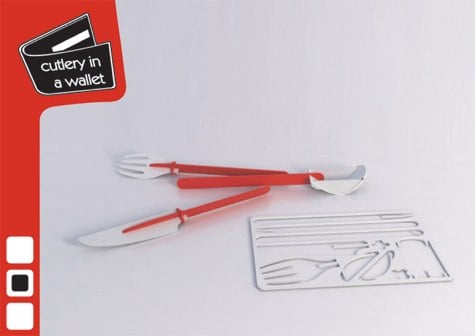Latest Gear Live Videos
Dining in 2015 Design Competition

Posted by Jenny Lewis Categories: Features, Trends, Utensils, Kitchen Gadgets,

You may not think much of your silverware or your plates, but someone does. The results of designboom’s Dining in 2015 design competition were announced a few months back, and there were a number of fantastic entries. Out of a total of 4843 entries from 98 countries, the five person jury narrowed it down to 3 first prize entries and an honorable mention from a shortlist of 160 amazing entries. My favorite entry from the shortlist, pictured above, is the “cutlery in a wallet,” designed by Alberto Ghirardello of Italy. It was “designed to facilitate outdoor eating,” and I can’t think of an easier and more compact way to do exactly that.
Format
Advertisement
History of the Salt Shaker and Salt Cellar
Posted by Janie Franz Categories: Utensils, History, Spices,
 Salt shakers were invented in 1858 by John Mason, the guy who invented the screw-top Mason jar. He made little screw-top jars to keep salt in at the table and keep it from caking from the humidity. But these were short-lived. Just over a decade later, salt was more finely milled and ceramic containers with perforations in their tops were invented. In between these two salt containers, C. P. Crossman patented an agitator in his shalt shaker in 1871 that broke up the clumps that always formed so the salt would always be free-flowing. Before these inventors, there were salt mills like pepper grinders, that ground up the salt into small bits.
Salt shakers were invented in 1858 by John Mason, the guy who invented the screw-top Mason jar. He made little screw-top jars to keep salt in at the table and keep it from caking from the humidity. But these were short-lived. Just over a decade later, salt was more finely milled and ceramic containers with perforations in their tops were invented. In between these two salt containers, C. P. Crossman patented an agitator in his shalt shaker in 1871 that broke up the clumps that always formed so the salt would always be free-flowing. Before these inventors, there were salt mills like pepper grinders, that ground up the salt into small bits.
The salt cellar, also called the open salt, was a special dish that held salt. These were bowl-shaped dishes without lids. As early as the middle ages in well-to-do households, the head of the house was given a salt bowl called a master salt with a tiny silver spoon. He would pass it around the table to his guests, and each would help themselves. This custom continued until WW II in some households, but has since passed by the wayside.
Today, however, you can still find salt cellars, but these now have lids. These salt cellars come in porcelain, glass, or wood, but aren’t usually placed on the table for service during a meal. They are used at the stove or on the counter so that modern cooks can grab a pinch of salt as they prepare food.
 Wash your knives immediately after use to avoid food build up on the knife edge. Don’t put them in the dishwasher since the blade may become damaged. Handwash and dry on a soft towel. Do not store you knives in a drawer (unless it’s a knife drawer with a built in wooden block). Store your knives in a wooden block. An angled knife block makes retrieving the proper knife easier.
Wash your knives immediately after use to avoid food build up on the knife edge. Don’t put them in the dishwasher since the blade may become damaged. Handwash and dry on a soft towel. Do not store you knives in a drawer (unless it’s a knife drawer with a built in wooden block). Store your knives in a wooden block. An angled knife block makes retrieving the proper knife easier.
Avoid cutting food on hard surfaces like glass cutting boards. These can dull your knives quickly. Instead, use a cutting board with some give such as those made of wood or polyethylene.
Remember: A dull knife is a dangerous knife. Use a steel or diamond to keep your knives sharp. Each time a knife blade cuts through something, its edge is malformed microscopically. A few strokes of a knife across a steel or a diamond removes these microscopic bits of metal and re-establishes a sharp edge. Run your knives over the steel before every use. And, if you are planning a marathon cooking session and will be chopping veggies all day, use the steel often.
Chef Scott says: Avoid standard knife sharpeners, especially the high speed electric ones. These machines grind the knife edge down, making it thinner. Once the edge is honed in that fashion, it must be sharpened regularly.
Herb Mills Help Add Appeal With Ease
Posted by Janie Franz Categories: Utensils, How To, Kitchen Gadgets,
Fresh herbs can add zest to salads and soups or eye appeal as a garnish on an entree, but mincing them fine enough by hand can be a labor of love and can take a long time. Using a hand herb mill might save you some time and effort. These gadgets, a little over 8 inches long, have rotary steel blades that can make short work of mincing herbs and produce them as finely as any master chef.
All you do is select your favorite herbs; for example, a sprig of parsley or cilantro or a bunch of basil. Wash the herbs and pat dry on a paper towel. Put them in the hopper of the mill and crank away.
Many herb mills are made of stainless steel and are dishwasher safe. Often the handles can be adjusted for the person who is right-handed or left-handed. The mill can also be used to chop nuts.
 Every chef will tell you that you have to have the right tools to cook with, and a good set of knives is essential. If you can’t afford a complete assortment and a wooden knife block, buy a good paring knife, a chef’s knife (sometimes called a cook’s knife or a French knife), and a slicer. The paring knife should be small enough to fit into the hand comfortably but big enough to do the job it’s intended for. A slicer usually has a long, thin blade and is used to cut cooked meats and poultry. It is sometimes called a carving knife.
Every chef will tell you that you have to have the right tools to cook with, and a good set of knives is essential. If you can’t afford a complete assortment and a wooden knife block, buy a good paring knife, a chef’s knife (sometimes called a cook’s knife or a French knife), and a slicer. The paring knife should be small enough to fit into the hand comfortably but big enough to do the job it’s intended for. A slicer usually has a long, thin blade and is used to cut cooked meats and poultry. It is sometimes called a carving knife.
A chef’s knife has a wider blade than the slicer and can range from six to twelve inches long. It is usually heavy and used to cut food by rocking on the pointed end and slicing downward. Smaller chef’s are great for chopping small fruits and vegetables and herbs, and larger blades may be used for bigger items. For most people, an 8 inch or a 10 inch chef’s knife is the ideal size. It’s big enough to attack a variety of foods yet is not unwieldily. Some home cooks prefer the 10 inch blade because it has enough weight and length to go after celery and carrots and make short work of them.
Serrated knives, called Japanese Santoku knives, are good, especially for the cook who uses a chef’s knife like a cleaver. These knives, however, are difficult to keep sharp. Though they will retain their edge initially for a long time without having to use a steel, the serrations make it difficult to sharpen. The only exception is the bread knife which is serrated but does not wear down as much because it saws through soft surfaces.
The Salad Chef and The Gourmet Oil Mister
Posted by Janie Franz Categories: Utensils, Kitchen Gadgets, Condiments, Salad,
 The Salad Chef is ideal for the extreme home gourmet cook. You create your salad dressing mixture in the glass carafe, which has pre-marked lines for oils and vinegars. Then, you insert the mini battery-powered emulsifing blender (what Emeril often calls a “Boat Motor”) into the carafe and blend away. The Salad Chef comes with an instruction booklet and fill-line charts so you don’t even have to measure
The Salad Chef is ideal for the extreme home gourmet cook. You create your salad dressing mixture in the glass carafe, which has pre-marked lines for oils and vinegars. Then, you insert the mini battery-powered emulsifing blender (what Emeril often calls a “Boat Motor”) into the carafe and blend away. The Salad Chef comes with an instruction booklet and fill-line charts so you don’t even have to measure
The Gourmet Oil Mister is a sleek stainless steel container that can be filled with oil or even a thin salad dressing. You pump the can to build up the pressure and then spray onto your salad. You can also use it to spray pans or directly onto meats, fish, or veggies. Many of the commercial oil sprays have additives (usually alcohol) to atomize the oil. Pump sprays are an alternative, but even then you can’t always get your favorite brand of olive oil or other vegetable oil in them. This way, you can use your favorite oils and not add something non-food related to your meal.
 Though you wash salad greens thoroughly, you don’t want the leaves to remain wet or your salad dressings will slide right off. That’s why a salad spinner is essential for any home cook. A salad spinner uses centrifugal force to spin the water away from the salad greens to the sides of the container. The large pump action ones are the best. You don’t have to crank the thing. You just pump the pump in the middle and around the salad basket goes. It has a non-skid base to keep the spinner from flying around your kitchen and comes with a brake that will slow the basket so you can dive right into your greens.
Though you wash salad greens thoroughly, you don’t want the leaves to remain wet or your salad dressings will slide right off. That’s why a salad spinner is essential for any home cook. A salad spinner uses centrifugal force to spin the water away from the salad greens to the sides of the container. The large pump action ones are the best. You don’t have to crank the thing. You just pump the pump in the middle and around the salad basket goes. It has a non-skid base to keep the spinner from flying around your kitchen and comes with a brake that will slow the basket so you can dive right into your greens.
Some models come with a suction cup base and others have a crank on top instead of a pump. Whatever model you get, make sure it the basket comes with a solid bottomed bowl. There are some out there with holes in the bottom so you have to use them over the sink. Otherwise, you get water all over the place.
Advertisement
© Gear Live Media, LLC. 2007 – User-posted content, unless source is quoted, is licensed under a Creative Commons Public Domain License. Gear Live graphics, logos, designs, page headers, button icons, videos, articles, blogs, forums, scripts and other service names are the trademarks of Gear Live Inc.


